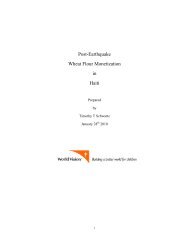Post Earthquake Jacmel (Haiti) Report and EMMA
You also want an ePaper? Increase the reach of your titles
YUMPU automatically turns print PDFs into web optimized ePapers that Google loves.
14<br />
4.2. The Internal <strong>Haiti</strong>an Marketing System<br />
For the purposes of this study, a discussion of the internal marketing system begins with the<br />
Regional Rotating Market System found in the Southeast <strong>and</strong> the extreme commoditization with<br />
which people in the area interact. This market system is spatially characterized by open air<br />
markets held in specific locations on specific days of the week. The system is such that<br />
inhabitants of any particular area are within walking-distance to at least five major markets per<br />
week. As with the rest of <strong>Haiti</strong>, the transactions that take place in these markets--as well as<br />
transactions outside of the markets--are cash based. But an important feature of the market is that<br />
many of the items sold are household necessities. xvi This is not to say that markets are stocked<br />
entirely with local products. There are also imported staples (spaghetti, flour, rice, beans, salami)<br />
as well as tools, utensils, clothing, <strong>and</strong> inexpensive knickknacks (soaps, hair ties, used clothing,<br />
shoes, wash basins, pots <strong>and</strong> pans, dishes, drinking glasses, eating utensils, machetes, hoes, <strong>and</strong><br />
kerosene). But whether imported or produced locally, the overwhelming bulk of items sold in the<br />
rural marketplaces relate directly to subsistence. xvii<br />
The vigorous, cash oriented market system <strong>and</strong> commoditization-mentality being<br />
described is also manifest in a dazzling degree of specialization in both the production of local<br />
material goods <strong>and</strong> provision of services. xviii But, arguably the most important aspect of the<br />
regional marketing system is the role it plays, not simply as a place to purchase, but in generating<br />
household income through selling. The overwhelming majority of women who live in the area<br />
are involved in trading such that commerce is the primary feminine economic opportunity; <strong>and</strong><br />
together with agricultural <strong>and</strong> livestock production is one of the three pillars of <strong>Haiti</strong>‘s internal<br />
market system. Women use commercial activity as a means of earning money <strong>and</strong> of extending<br />
household savings. The tendency to commoditize is such that a local person who is given a bag<br />
of rice or earns it in a food-for-work project will generally not stash it in a dark recess of the<br />
house to be doled out bit by bit over a period of weeks or months. Rather, the rice is separated. A<br />
large portion is sent straight to the market or sold at below market price to obtain cash that is<br />
then used to engage in more lucrative marketing activities <strong>and</strong> to purchase other foods <strong>and</strong><br />
provisions as needs arise.<br />
Female involvement in commerce is something that has the potential to put women on<br />
economically equal footing with men, particularly middle aged women who have a sufficient<br />
number of adolescent children. These children maintain the other productive activities of the<br />
household while the woman is away engaged in itinerant marketing activities. It is from this class<br />
of women that come the madam sara, a major player in the internal market system <strong>and</strong> one so<br />
commonly misunderstood as to warrant special mention <strong>and</strong> clarification here. xix<br />
4.2.1. Madam Sara<br />
Named for a migratory bird that assiduously searches for <strong>and</strong> finds food wherever it goes, the<br />
madam sara (pronounced ma-dan sé-ra) acts as the critical market link between rural producers<br />
<strong>and</strong> the urban consumer, most importantly the 30% of the national population who live in Portau-Prince,<br />
many of whom work for wages <strong>and</strong> receive remittances from overseas migrants. In the<br />
Southeast there are several characteristics of the madam sara that outsiders <strong>and</strong> urban based<br />
<strong>Haiti</strong>ans commonly misunderst<strong>and</strong>.
















